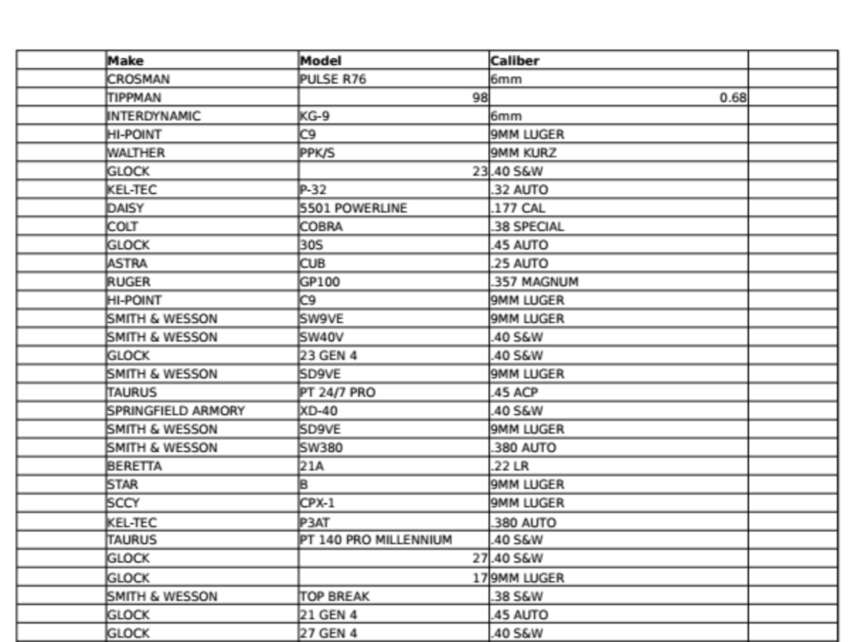D.C.'s Cache of Seized Illegal Guns Has Antique Rifles and Paintball Guns, But Few Bump-Stock-Compatible Weapons
I sent a FOIA request to the lab that processes guns seized by police in the nation's capital. Here's what I found out.

When I wrote recently about D.C. Mayor Muriel Bowser's proposal to ban bump stocks, I noted that the legislation would be entirely strategic and/or symbolic, since D.C.'s gun laws already outlaw most guns that can be readily fitted with a bump stock.
But I was still curious about how many illegal bump-stock-compatible wepaons there might be in the District. So I sent a Freedom of Information Act request to D.C. government asking for details on the district's illegal guns.
In response I received a spreadsheet from the D.C. Department of Forensic Sciences (DFS), which forensically processes illegal guns that fall into the hands of the city police. The spreadsheet details the make, model, and caliber of 2,192 guns processed in 2017.
Here are a few things I learned from the data:
1) Very few of the guns on the list were bump-stock-compatible.
First, a disclaimer: Determining whether a gun will accept a bump stock is not always a straightforward yes/no classification. The question is complicated by homemade bump stocks, custom fabrications, and the like. For these purposes, I called a gun "bump-stock-compatible" only if it was a semi-automatic AR-15 or AK-47 pattern rifle or carbine. Those types of firearms are, as far as I could determine, the only ones for which bump fire stocks are currently manufactured and sold at any kind of mass-market scale.
Using those parameters, I found just 27 guns on the list of 2,192 which were bump-stock-compatible. That's 1.2 percent, which suggests it is unlikely that D.C. has a significant problem with bump stocks being used in crimes.
2) Unsurprisingly, the overwhelming majority were pistols.
Amidst national debates about mass shootings, bump stocks, and "assault weapons," it often seems to get forgotten that, nationwide, handguns play a vastly larger role in gun crime than do rifles ("assault"-style and otherwise) or shotguns. The DFS data reflect that. Judging by the caliber, at least 1,800 of the 2,192 entries were semi-automatic handguns or revolvers.
3) A surprising number of antique and historical firearms appear on the list.
Before seeing it, if you had asked me how many bolt-action infantry rifles from World War I and before would be on the list of guns seized by police in D.C., I'd probably have said zero. But I'd have been wrong. The list included several antique rifles, including a handful of bolt-action rifles that would have been military standard issue around 1895 or so. How these guns ended up in the custody of the Metropolitan Police Department is anyone's guess. (Maybe someone's unregistered antique firearms collection was discovered?) As a history enthusiast, I cringe at the thought of these rifles, which wouldn't be out of place in a museum, being destroyed.
4) Some of these guns weren't guns at all.
I noticed that several entries in the list I received gave ".177," ".68," or "6mm" as the caliber of the gun in question. These aren't common bullet calibers, so I looked up the makes and models. As it turned out, the "6mm" entries were all airsoft guns, a realistic toy weapon which shoots a 6mm plastic sphere at velocities too low to break the skin. The .177s were BB and pellet guns, something I should have been able to guess from the fact that the manufacturer was listed as "Daisy." And the .68s? I thought initially that these might be some sort of muzzle-loading hunting rifles, but nope. Google provided the answer: paintball guns.
How exactly it came to be that 15 airsoft guns, 46 BB guns, and 4 paintball guns were sent to D.C.'s crime lab for forensic analysis, I don't know. It's certainly possible they were being carried as decoy guns (which is still illegal in D.C.), but I somehow doubt they'd provide much in the way of useful ballistics. Oh, well.


Show Comments (61)